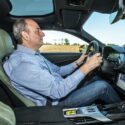Road cars – Andrew Frankel
Lotus Elise
A former Lotus owner himself, Frankel recalls what drew him to the marque in the first place, explains why an Elise is more involving than a Veyron and ponders the firm’s future.
Very briefly in the late 1980s, I was what was described as ‘something in the City’. In my case that something was just about the most useless incompetent ever to have the misfortune to set foot in the Square Mile. After brief attempts to be both a commodity broker and bond dealer, I left tail between legs – the only person in the financial sector who failed to make money in the tertiary stage of Thatcher’s bull market.
But it wasn’t all bad, because while my mates did their best to impress young women in a motley assortment of cobbled-together wreckage, I had a Lotus. Had it ever reached a destination without going wrong it would have doubtless done wonders for my love life, but while I found standing at the side of the road waiting for an AA truck in a dinner jacket rather amusing, the same could not be said for my ball-gowned companions.
The early Esprit might have looked good and gone fast with Bond behind the wheel, but with Frankel in situ it usually just broke down. But on those rare occasions when it did work, it was awesome. Indeed it would not be too much to say that it was the car that taught me to drive. Not in a bald, technical sense, but that which turns a young, gauche lunatic into a mechanically sensitive enthusiast. Of course I then got sacked again and it had to be sold.
Even so, and with the benefit of hindsight, I can see now it was the wrong kind of Lotus. It came from a period when Chapman tried to push Lotus in a direction it did not care to go and the financial strife this brought the company was serious and real.
Somehow Lotus held it all together until the company could be sold, first to General Motors, then to Romano Artioli who decided to go back to basics and build a Lotus true to its original values: affordable, lightweight and advanced. It was named Elise after his grand-daughter and, almost overnight, fortunes changed: Lotus had found its most successful product ever.
Ten years on, the Elise still stacks up well, especially if you choose the latest version, the Elise S. This is not a hideously expensive track-day warrior but a no-frills version with a 134bhp Toyota engine and a list price of £23,995. It is, to me, everything a Lotus should be. It’s still quick enough to be on the far side of 60mph less than six seconds from rest, it has quite skinny tyres to keep the steering full of feedback, yet it can carry so much speed through corners that if you drive it well, you’ll still dust almost everything at your local track day.
Drive one today and it will prove in the first few feet that cost is as poor an indicator of fun as raw speed. You can drive an Elise down a country lane at an entirely legal and sensible rate, and simply feeling the contours of the road faithfully reproduced through the steering wheel will remind you how remote and aloof most modern, even quite sporting cars are. A Bugatti Veyron is an astonishing engineering achievement but, believe me, it won’t do this.
Nor would its two-tonne weight, enormous girth and grip allow you the simple pleasure of flicking into a quickish corner and tuning your line from entry through apex to exit entirely with your right foot. For that you need a light and small car that’s been set up by that rare breed of chassis genius who, while once common, is now confined to isolated patches near towns such as Norwich and Modena.
But, it seems, the desire to break out from this traditional territory that led Lotus so far astray in the ’70s is still nibbling away. I won’t dwell too long on the new Europa S because I cared very little for it. I didn’t like the way it looked nor the way it drove. I didn’t like having to clamber in and out of its confined quarters – rarely a problem in an Elise because the roof is almost always off – and most of all I did not like its £33,895 price. It’s all but 10 grand more than an Elise S, yet will shave just 0.2sec off its 0-60mph time. It’s a nonsense.
But the Elise (and its heart-stoppingly exciting brother, the Exige) is not. They even build them to last these days.
And then there’s the Exige 265E which is by far the most exciting of all the dozens of Lotus road cars I’ve driven, and only partly because it’s the fastest. Your eyes may glaze over when I tell you this Exige is designed to run on bio-ethanol, but stay with me. Yes, using this fuel does reduce its Co2 output by up to 70 per cent, but it also increases the power of its 1.8-litre engine from 220bhp to 265bhp. It sounds and goes like a maniac. Think 3.8sec to 60mph in a car weighing less than a small shopping hatchback. And you’re doing the planet a favour.
Sadly the 265E can’t be sold and instead acts as a shop window for Lotus’s engineering consultancy, but it is indicative of the fact that real innovation is alive and well in Hethel. And it is in real driving machines like this and the Elise S that the future lies for Lotus. This was forgotten back in the ’70s and the result lost the company its independence and damn near finished it off. History has a habit of repeating itself, but not this time, I hope.

